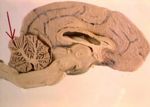Hindbrain - Anatomy & Physiology
Introduction
The hind brain is also called the rhombencephalon and is the brain stem that provides the connection between the spinal cord and the rest of the brain. The hind brain contains many vital structures including the Medulla Oblongata, the Pons (the link between the cerebellum, forebrain and mid-brain) and the majority of the cranial nerves, III to XII. In general the brain stem governs essential functions that are carried out sub-consciously via reflexes.
Hind Brain Development
Hind Brain Functions
Medulla Oblongata
Nuclei in the Medulla Oblongata control the level of heart activity including rate and contractility. The Medulla Oblongata also controls other related functions including blood pressure and distribution of blood to different organs. In conjunction with the nuclei found in the Pons, the Medulla Oblongata also exerts an influence on respiratory movements.
Pons
As shown above, the Pons is able to exert some influence on respiratory movements and in some studies has also been shown to influence many digestive processes.
Cranial Nerves
Structure and Function
| Structures Present | Function | ||
|---|---|---|---|
| Hindbrain (Rhombencephalon) | Myelencephalon - Medulla Oblongata
Metencephalon - Pons and Cerebellum |
Medulla Oblongata - Cranial nerves, hearing, visceral fibres
Cerebellum - Posture, balance etc |
Medulla Oblongata
Pons
Cerebellum
- The cerebellum:
- Inhibits upper motor neurons
- Co-ordinates movement
Species Differences
- The size of the brain differs between species, but otherwise the structure is quite constant.
Links
| This article is still under construction. |
